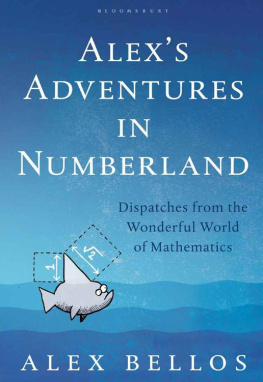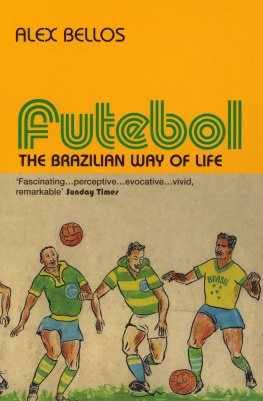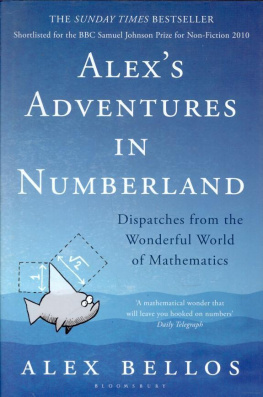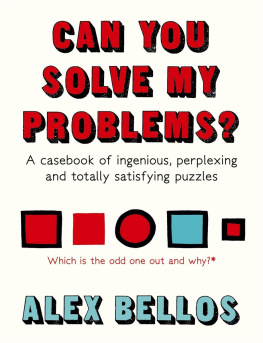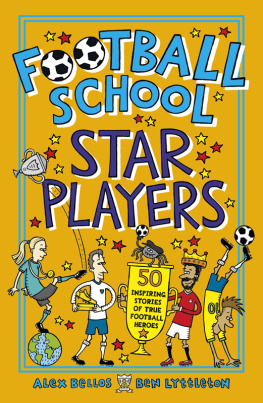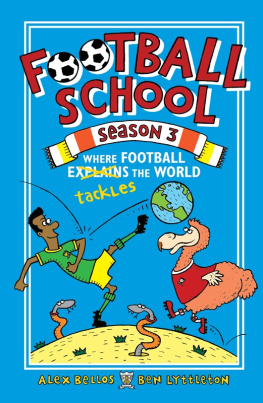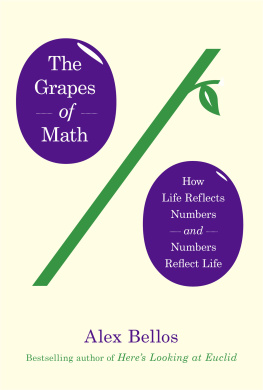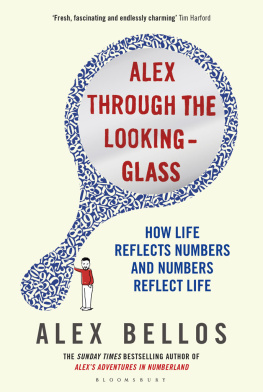Alex Bellos - Alexs Adventures in Numberland
Here you can read online Alex Bellos - Alexs Adventures in Numberland full text of the book (entire story) in english for free. Download pdf and epub, get meaning, cover and reviews about this ebook. year: 2011, publisher: Bloomsbury Publishing Plc, genre: Children. Description of the work, (preface) as well as reviews are available. Best literature library LitArk.com created for fans of good reading and offers a wide selection of genres:
Romance novel
Science fiction
Adventure
Detective
Science
History
Home and family
Prose
Art
Politics
Computer
Non-fiction
Religion
Business
Children
Humor
Choose a favorite category and find really read worthwhile books. Enjoy immersion in the world of imagination, feel the emotions of the characters or learn something new for yourself, make an fascinating discovery.
- Book:Alexs Adventures in Numberland
- Author:
- Publisher:Bloomsbury Publishing Plc
- Genre:
- Year:2011
- Rating:4 / 5
- Favourites:Add to favourites
- Your mark:
- 80
- 1
- 2
- 3
- 4
- 5
Alexs Adventures in Numberland: summary, description and annotation
We offer to read an annotation, description, summary or preface (depends on what the author of the book "Alexs Adventures in Numberland" wrote himself). If you haven't found the necessary information about the book — write in the comments, we will try to find it.
Alexs Adventures in Numberland — read online for free the complete book (whole text) full work
Below is the text of the book, divided by pages. System saving the place of the last page read, allows you to conveniently read the book "Alexs Adventures in Numberland" online for free, without having to search again every time where you left off. Put a bookmark, and you can go to the page where you finished reading at any time.
Font size:
Interval:
Bookmark:


For my mother and father
First published in Great Britain in 2010
Copyright 2010 by Alex Bellos
Illustrations 2010 by Andy Riley
The moral right of the author has been asserted
Bloomsbury Publishing Plc, 36 Soho Square, London W1D 3QY
A CIP catalogue record for this book is available from the British Library
Mathematical diagrams by Oxford Designers and Illustrators
All papers used by Bloomsbury Publishing are natural, recyclable products made from wood grown in well-managed forests. The manufacturing processes conform to the environmental regulations of the country of origin.
www.bloomsbury.com/alexbellos
Plate Section Picture Credits:
p. 1 (top), p. 1 (bottom), p. 6 (top), p. 6 (bottom), p. 7 (top), p. 7 (bottom), p. 12 (top), p. 15 (top), p. 15 (bottom), p. 16 (top) Alex Bellos; pp. 23 SR Euclid Collection, UCL Library Services, Special Collections; p. 4 (top), p. 4 (bottom) Robert Lang; p. 5 (top) Eva Madrazo, 2009. Used under license from Shutterstock.com; p. 5 (bottom) Neil Mason; p. 8 Le Casse-tte en portraits, Gandais, Paris, 1818, from the Slocum Puzzle Collection, Lilly Library; p. 9 Thanks to Jerry Slocum; p. 10 (top left), p. 10 (top right), p. 10 (bottom left), p. 10 (bottom right), p. 11 Christopher Lane; p. 12 (bottom), p. 13 Thanks to Eddy Levin; p. 14 FLC/ADAGP, Paris and DACS, London 2009; p. 16 (bottom) Daina Taimina.
In which the author tries to find out where numbers come from, since they havent been around that long. He meets a man who has lived in the jungle and a chimpanzee who has always lived in the city.
In which the author learns about the tyranny of ten, and the revolutionaries plotting its downfall. He goes to an after-school club in Tokyo, where the pupils learn to calculate by thinking about beads.
In which the author almost changes his name because the disciple of a Greek cult leader says he must. Instead, he follows the instructions of another Greek thinker, dusts off his compass and folds two business cards into a tetrahedron.
In which the author travels to India for an audience with a Hindu seer. He discovers some very slow methods of arithmetic and some very fast ones.
In which the author is in Germany to witness the worlds fastest mental multiplication. It is a roundabout way to begin telling the story of circles, a transcendental tale that leads him to New York and a new appreciation of the 50p piece.
In which the author explains why numbers are good but letters are better. He visits a man in Braintree who collects slide-rules and hears the tragic tale of their demise. Includes an exposition of logarithms, a dictionary of calculator words and how to make a superegg.
In which the author is on a mathematical puzzle quest. He investigates the legacy of two Chinese men one was a dim-witted recluse and the other fell off the Earth and then flies to Oklahoma to meet a magician.
In which the author is first confronted with the infinite. He encounters an unstoppable snail and a devilish family of numbers.
In which the author meets a Londoner with a claw who claims to have discovered the secret of beautiful teeth.
In which the author remembers the dukes of hasard and goes gambling in Reno. He takes a walk through randomness and ends up in an office block in Newport Beach, California where, if he looked across the ocean, he might be able to spot a lottery winner on a desert island in the South Pacific.
In which the authors farinaceous overindulgence is an attempt to savour the birth of statistics.
In which the author terminates his journey with crisps and crochet. Hes looking at Euclid, again, and then at a hotel with an infinite number of rooms that cannot cope with a sudden influx of guests.
In the summer of 1992 I was working as a cub reporter at the Evening Argus in Brighton. My days were spent watching recidivist teenagers appear at the local magistrates court, interviewing shopkeepers about the recession and, twice a week, updating the opening hours of the Bluebell Railway for the papers listings page. It wasnt a great time if you were a petty thief, or a shopkeeper, but for me it was a happy period in my life.
John Major had recently been re-elected as prime minister and, flush from victory, he delivered one of his most remembered (and ridiculed) policy initiatives. With presidential seriousness, he announced the creation of a telephone hotline for information about traffic cones a banal proposal dressed up as if the future of the world depended on it.
In Brighton, however, cones were big news. You couldnt drive into town without getting stuck in roadworksThe main route from London the A23 (M) was a corridor of striped orange cones all the way from Crawley to Preston Park. With its tongue firmly in its cheek, the Argus challenged its readers to guess the number of cones that lined the many miles of the A23 (M). Senior staff congratulated themselves on such a brilliant idea. The village fte-style challenge explained the story while also poking fun at central government: perfect local-paper stuff.
Yet only a few hours after the competition was launched, the first entry was received, and in it the reader had guessed the correct number of cones. I remember the senior editors sitting in dejected silence in the newsroom, as if an important local councillor had just died. They had aimed to parody the prime minister, but it was they who had been made to look like fools.
The editors had assumed that guessing how many cones there were on 20 or so miles of motorway was an impossible task. It self-evidently wasnt and I think I was the only person in the building who could see why. Assuming that cones are positioned at identical intervals, all you need to do is make one calculation:
Number of cones = length of road distance between cones
The length of road can be measured by driving down it or by reading a map. To calculate the distance between cones you just need a tape measure. Even though the space between cones may vary a little, and the estimated length of road may also be subject to error, over large distances the accuracy of this calculation is good enough for the purposes of winning competitions in local papers (and was presumably exactly how the traffic police had counted the cones in the first place when they supplied the Argus with the right answer).
I remember this incident very clearly because it was the first moment in my career as a journalist that I realized the value of having a mathematical mind. It was also disquieting to realize just how innumerate most journalists are. There was nothing very complicated about finding out how many cones were lined alongside a road, yet for my colleagues the calculation was a step too far.
Two years previously I had graduated in mathematics and philosophy, a degree with one foot in science and the other in the liberal arts. Entering journalism was a decision, at least superficially, to abandon the former and embrace the latter. I left the Argus shortly after the cones fiasco, moving to work on papers in London. Eventually, I became a foreign correspondent in Rio de Janeiro. Occasionally my heightened aptitude for numbers was helpful, such as when finding the European country whose area was closest to the most recently deforested swathe of Amazon jungle, or when calculating exchange rates during various currency crises. But essentially, it felt very much as if I had left maths behind.
Font size:
Interval:
Bookmark:
Similar books «Alexs Adventures in Numberland»
Look at similar books to Alexs Adventures in Numberland. We have selected literature similar in name and meaning in the hope of providing readers with more options to find new, interesting, not yet read works.
Discussion, reviews of the book Alexs Adventures in Numberland and just readers' own opinions. Leave your comments, write what you think about the work, its meaning or the main characters. Specify what exactly you liked and what you didn't like, and why you think so.

